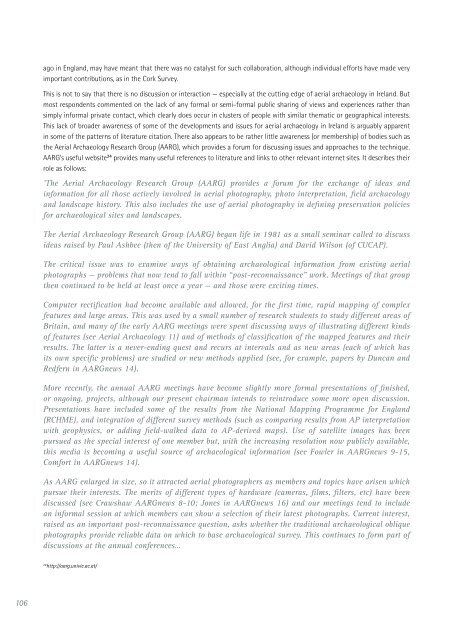Aerial Archaeology in Ireland - The Heritage Council
Aerial Archaeology in Ireland - The Heritage Council
Aerial Archaeology in Ireland - The Heritage Council
You also want an ePaper? Increase the reach of your titles
YUMPU automatically turns print PDFs into web optimized ePapers that Google loves.
106<br />
ago <strong>in</strong> England, may have meant that there was no catalyst for such collaboration, although <strong>in</strong>dividual efforts have made very<br />
important contributions, as <strong>in</strong> the Cork Survey.<br />
This is not to say that there is no discussion or <strong>in</strong>teraction — especially at the cutt<strong>in</strong>g edge of aerial archaeology <strong>in</strong> <strong>Ireland</strong>. But<br />
most respondents commented on the lack of any formal or semi-formal public shar<strong>in</strong>g of views and experiences rather than<br />
simply <strong>in</strong>formal private contact, which clearly does occur <strong>in</strong> clusters of people with similar thematic or geographical <strong>in</strong>terests.<br />
This lack of broader awareness of some of the developments and issues for aerial archaeology <strong>in</strong> <strong>Ireland</strong> is arguably apparent<br />
<strong>in</strong> some of the patterns of literature citation. <strong>The</strong>re also appears to be rather little awareness (or membership) of bodies such as<br />
the <strong>Aerial</strong> <strong>Archaeology</strong> Research Group (AARG), which provides a forum for discuss<strong>in</strong>g issues and approaches to the technique.<br />
AARG’s useful website 24 provides many useful references to literature and l<strong>in</strong>ks to other relevant <strong>in</strong>ternet sites. It describes their<br />
role as follows:<br />
’<strong>The</strong> <strong>Aerial</strong> <strong>Archaeology</strong> Research Group (AARG) provides a forum for the exchange of ideas and<br />
<strong>in</strong>formation for all those actively <strong>in</strong>volved <strong>in</strong> aerial photography, photo <strong>in</strong>terpretation, field archaeology<br />
and landscape history. This also <strong>in</strong>cludes the use of aerial photography <strong>in</strong> def<strong>in</strong><strong>in</strong>g preservation policies<br />
for archaeological sites and landscapes.<br />
<strong>The</strong> <strong>Aerial</strong> <strong>Archaeology</strong> Research Group (AARG) began life <strong>in</strong> 1981 as a small sem<strong>in</strong>ar called to discuss<br />
ideas raised by Paul Ashbee (then of the University of East Anglia) and David Wilson (of CUCAP).<br />
<strong>The</strong> critical issue was to exam<strong>in</strong>e ways of obta<strong>in</strong><strong>in</strong>g archaeological <strong>in</strong>formation from exist<strong>in</strong>g aerial<br />
photographs — problems that now tend to fall with<strong>in</strong> “post-reconnaissance” work. Meet<strong>in</strong>gs of that group<br />
then cont<strong>in</strong>ued to be held at least once a year — and those were excit<strong>in</strong>g times.<br />
Computer rectification had become available and allowed, for the first time, rapid mapp<strong>in</strong>g of complex<br />
features and large areas. This was used by a small number of research students to study different areas of<br />
Brita<strong>in</strong>, and many of the early AARG meet<strong>in</strong>gs were spent discuss<strong>in</strong>g ways of illustrat<strong>in</strong>g different k<strong>in</strong>ds<br />
of features (see <strong>Aerial</strong> <strong>Archaeology</strong> 11) and of methods of classification of the mapped features and their<br />
results. <strong>The</strong> latter is a never-end<strong>in</strong>g quest and recurs at <strong>in</strong>tervals and as new areas (each of which has<br />
its own specific problems) are studied or new methods applied (see, for example, papers by Duncan and<br />
Redfern <strong>in</strong> AARGnews 14).<br />
More recently, the annual AARG meet<strong>in</strong>gs have become slightly more formal presentations of f<strong>in</strong>ished,<br />
or ongo<strong>in</strong>g, projects, although our present chairman <strong>in</strong>tends to re<strong>in</strong>troduce some more open discussion.<br />
Presentations have <strong>in</strong>cluded some of the results from the National Mapp<strong>in</strong>g Programme for England<br />
(RCHME), and <strong>in</strong>tegration of different survey methods (such as compar<strong>in</strong>g results from AP <strong>in</strong>terpretation<br />
with geophysics, or add<strong>in</strong>g field-walked data to AP-derived maps). Use of satellite images has been<br />
pursued as the special <strong>in</strong>terest of one member but, with the <strong>in</strong>creas<strong>in</strong>g resolution now publicly available,<br />
this media is becom<strong>in</strong>g a useful source of archaeological <strong>in</strong>formation (see Fowler <strong>in</strong> AARGnews 9-15,<br />
Comfort <strong>in</strong> AARGnews 14).<br />
As AARG enlarged <strong>in</strong> size, so it attracted aerial photographers as members and topics have arisen which<br />
pursue their <strong>in</strong>terests. <strong>The</strong> merits of different types of hardware (cameras, films, filters, etc) have been<br />
discussed (see Crawshaw AARGnews 8-10; Jones <strong>in</strong> AARGnews 16) and our meet<strong>in</strong>gs tend to <strong>in</strong>clude<br />
an <strong>in</strong>formal session at which members can show a selection of their latest photographs. Current <strong>in</strong>terest,<br />
raised as an important post-reconnaissance question, asks whether the traditional archaeological oblique<br />
photographs provide reliable data on which to base archaeological survey. This cont<strong>in</strong>ues to form part of<br />
discussions at the annual conferences…<br />
24 http://aarg.univie.ac.at/

















